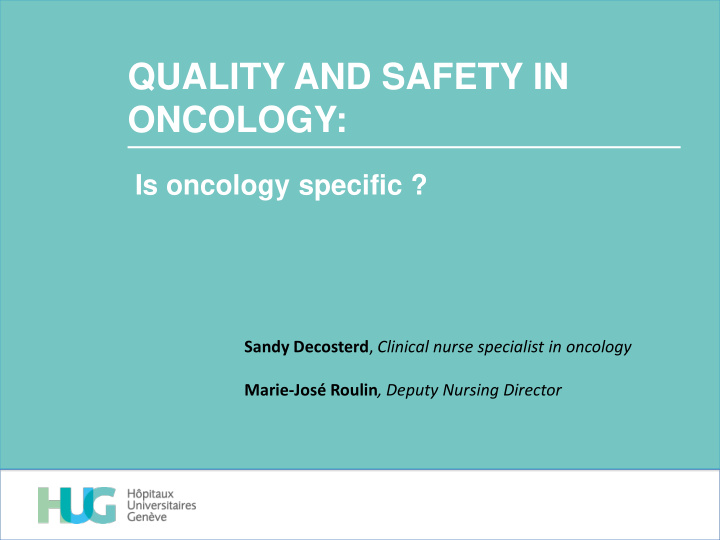



QUALITY AND SAFETY IN ONCOLOGY: Is oncology specific ? Sandy Decosterd , Clinical nurse specialist in oncology Marie-José Roulin , Deputy Nursing Director
SAFETY IN NURSING IN SWITZERLAND: nurses’ perspective Auer et al. (2014) Journal of Nursing Administration
HEALTHCARE PROFESSIONALS’ LIKELIHOOD OF SPEAKING UP ABOUT SAFETY CONCERNS: a Swiss vignette study Schwappach & Gehring (2014) PloS One
SWISS NATIONAL STRATEGY AGAINST CANCER: TWO PRIORITIES ARE LINKED TO NURSING Development of quality in medicine and care through the formulation of therapeutic guidelines or tools promoting integrated care. Participation and development of patients and families competencies
OUR CHOICES FOR THIS PRESENTATION • Focus on the patient-nurse interface • A Swiss perspective A general An oncology perspective perspective
Environment: staffing, legislation, structure, patient trajectory Person Patient Nurse centered care Interprofessionality: coordination, communication, sharing responsabilities
ETHICAL CARE: ICN code of ethics nursing and the individual • Respect of rights, values, customs and beliefs • Consent for care • Respect of confidentiality • Equity in access to health care • Respectfulness, compassion, trustworthiness and integrity • Nursing professional responsibility is to the patient ICN code of ethics, 2012, Geneva
ETHICAL CARE: ICN code of ethics nursing and practice/profession • Individual responsibility for maintaining competences • Ensuring the use of up to date technology and scientific advances • Determining and implementing standards of clinical nursing • Taking action to safeguard individuals during sensitive care. ICN code of ethics, 2012, Geneva
Environment: staffing, legislation, structure, patient trajectory Person Patient Nurse centered care Interprofessionality: coordination, communication, sharing responsabilities
KNOWLEDGE USE: the right information, at the right place, at the right time It implies Nursing k nowledge • Summarizing and structuring the pertinent brokers information for the context • Translating for clinician and management • Disseminating knowledge at the bedside McCormack et al. (2013) Implementation Science Pool et al. (2015) International Journal of Nursing Studies
SOURCES OF PRACTICE KNOWLEDGE FOR BEDSIDE NURSES: the right information, at the right place, at the right time Coaching at the bedside Regular contacts Nursing rounds Examples in oncology In-services Team case analysis Social interaction In-services educational intervention with Journal club individual coaching Protocoles Guided protocoles for chemotherapy Information in computerised care Oncology information flyers charts Unit based documents Flyers from the national cancer league Internet, Service blogs /Tweet/ SOS nursing standards WhatsApp Newsletters Estabrooks et al. (2005) Qualitative Health Research Gagnon et al. (2009) Infirmière Clinicienne
BARRIERS TO KNOWLEDGE USE • 4 national languages (french is a minority language) • Few national guidelines/standards in oncology nursing • Strong cultural link with neighboring countries
Environment: staffing, legislation, structure, patient trajectory Person Patient Nurse centered care Interprofessionality: coordination, communication, sharing responsabilities
COMPETENCIES : technical, relational, reflexive Therapy, surgery, radiotherapy, side Technicity, precision effects, procedures,.. Patient education, support , enabling Therapeutic self-care, giving bad news, palliative communication, care emotional support Reflexive, formalizing Developing practice knowledge
NURSING COMPETENCIES IN SWITZERLAND Based on the CANMED 2005 Framework Bachelor Specialty Nursing expert Master (CNS) Ledergerber, C., Mondoux, J., Sottas, B. (2009) Projet de compétences finales pour les professions de la santé HES, disponible sur : http://www.swissuniversities.ch/fileadmin/swissuniversities/Dokumente/FR/FH/Best_practice/1_Competences_finales_pour _les_professions_de_la_sante_HES_rapport_final.pdf
NURSES WITH A NURSING SCIENCES’ MASTER IN SWITZERLAND 349 nurses (mean age 40) 21% in oncology Somatic hospitals 53% Universities of Applied Sciences 27% Universities 12% Psychiatric hospitals 8% Long term care 5% Home care 3% Schwendimann R., Koch, R. (2013) Masterumfrage, ASI. Disponible sur: http://swiss-anp.ch/w/media/Akutelles/2013_05_20_Masterumfrage_2013_Bericht_4S_final.pdf
Environment: staffing, legislation, structure, patient trajectory Person Patient Nurse centered care Interprofessionality: coordination, communication, sharing responsabilities
PATIENTS’ CHARACTERISTICS: What are the patients’ characteristics that influence acuity ? Pilot study in four hospital wards • Oncology • General Medicine • Rehabilitation • Psychiatry (crisis unit) 1. Evaluation of the importance of 6 characteristics in a convenience sample of 184 patients 2. Identification of indicators for each characteristic Ansel, Ducloux, Ferreira, Genoud, Gonzales, Hamache, Herrault, Roulin (2015) Preliminary results, pilot study HUG.
IMPORTANCE OF PATIENTS’ CHARACTERISTICS STABILITY RESOURCES PARTICIPATION PREDICTABILITY VULNERABILITY N=184 COMPLEXITY oncology (n=46) Etude pilote HUG: Résultats préliminaires, 2015
VULNERABILITY Susceptibilty to stressors that may affect outcomes such as comorbidities , cognitive problems,…...., Ansel, Ducloux, Ferreira, Genoud, Gonzales, Hamache, Herrault, Roulin (2015) Preliminary results, pilot study HUG.
SWISS ADAPTATION OF THE ONCOLOGY ACUITY TOOL FROM BRENNAN P T Decosterd. Bavaux, Eicher, 2015 (Preliminary results)
Environment: staffing, legislation, structure, patient trajectory Person Patient Nurse centered care Interprofessionality: coordination, communication, sharing responsabilities
ENVIRONNEMENT legislation, role, staffing, reimbursement Federal law in No definition of scope of preparation on health professions practice. TODAY, counseling and teaching must be prescribed by a physician No recognition of nurses’ Change in the health autonomy of practice insurance federal law in consultation Counseling and targeted follow up of patients with oral anti-cancer medication must be prescribed by a physician
NURSES’ PER 1000 INHABITANTS Panorama de la santé 2011, OCDE
NURSING STAFFING Aiken et al. (2012) BMJ; 344.e1717
Environment: staffing, legislation, structure, patient trajectory Person Patient Nurse centered care Interprofessionality: coordination, communication, sharing responsabilities
INTERPROFESSIONALITY Coordinated care, patient trajectory, chronicity Multiprofessional Interprofessional Other Nurse Other Nurse Phys. Physician Knowing the others ’ Patient centered integrated care
DRIVING AND RESTRAINING FORCES Lack of expertise Patient and family Communication, teamwork, Complexity, vulnerability, sharing of responsabilities autonomy Interprofessional Professions Cultural silos practice Competencies sharing, optimize Values, perspective, systemic expertise vision Infrastructure Politique Schedules, rewards, levels, Cost control, accountability physician based financing Inspired from Heather et al. (2011) Nursing Outlook
INTERPROFESSIONALITY : Complexity indicators linked to interprofessionality Light patient Medium patient Heavy patient Non defined Professionals from Ethical questions Divergences or lack of therapeutic goals/ or in different disciplines dialogue between definition and services professionals (coordination) Ansel, Ducloux, Ferreira, Genoud, Gonzales, Hamache, Herrault, Roulin (2015) Résultats préliminaires, étude pilote HUG.
TAKE HOME MESSAGE Ethical nursing Quality and security Quality and security complex process
Environment: staffing, legislation, structure, patient trajectory Person Patient Nurse centered care Interprofessionality: coordination, communication, sharing responsabilities
Recommend
More recommend